
Schinia, commonly called flower moths, is a large genus of moths belonging to the family Noctuidae. The genus has a Holarctic distribution with the vast majority of species being found in North America, many with a very restricted range and larval food plant.

Renia is a genus of litter moths of the family Erebidae erected by Achille Guenée in 1854.
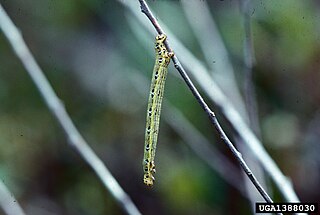
Cingilia is a monotypic moth genus in the family Geometridae erected by Francis Walker in 1862. Its only species, Cingilia catenaria, the chain-dotted geometer, chain dot geometer, chainspotted geometer or chain-spotted geometer, was first described by Dru Drury in 1773. It is found in North America from Nova Scotia south to Maryland and west to Kansas and Alberta.

Rivula propinqualis, the spotted grass moth or yellow snout-moth, is a moth of the family Erebidae. The species was first described by Achille Guenée in 1854. It is found throughout eastern North America from southern Canada southward to Florida and Texas and westward in the north to British Columbia and Washington. In North Carolina it is found from the Appalachian Mountains to the Atlantic coast.
Autographa bimaculata, the two-spotted looper moth, twin gold spot or double-spotted spangle, is a moth of the family Noctuidae. The species was first described by James Francis Stephens in 1830. It is found in North America from Newfoundland west, just short of the coast of British Columbia, north to the Northwest Territories and south to New Mexico in the west and Pennsylvania and Long Island in the east.
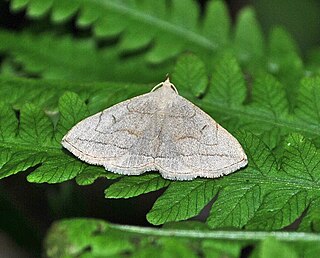
Zanclognatha pedipilalis, the grayish zanclognatha, is a litter moth of the family Erebidae. The species was first described by Achille Guenée in 1854. It is found in eastern North America, from Nova Scotia south to Florida and Mississippi, west to Alberta and Kansas.

Schinia nuchalis, the spotted sage moth, is a moth of the family Noctuidae. The species was first described by Augustus Radcliffe Grote in 1878. It is found from the Great Plains and Great Basin, from southern Saskatchewan, Alberta and British Columbia south to northern Arizona. The Eurasian Schinia scutosa is no longer considered a synonym of Schinia nuchalis.

Lophocampa maculata, the spotted tussock moth, mottled tiger or spotted halisidota, is a moth of the family Erebidae and the tribe Arctiini, the tiger moths. The species was first described by Thaddeus William Harris in 1841. It is found across Canada, the western parts of the United States, south in the Appalachians to South Carolina and Kentucky.
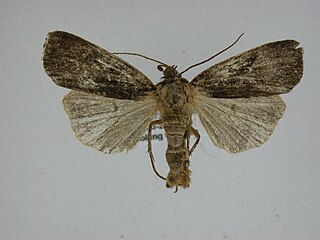
Pseudohermonassa bicarnea, the pink-spotted dart, is a moth of the family Noctuidae. The species was first described by Achille Guenée in 1852. It is found in eastern North America, and as far west as south-central Saskatchewan and central North Dakota, south to western North Carolina. It has recently been recorded from Tennessee.

Diachrysia balluca, the green-patched looper, is a moth of the family Noctuidae. The species was first described by Carl Geyer in 1832. It is found in north-eastern North America from Nova Scotia west to Manitoba and south to western North Carolina. Great Smoky Mountains National Park is the southern limit of this species. The only other records in the south are from the type locality of Georgia and a record from Liberty County in north-western Florida. These possibly represent strays.

Eutricopis nexilis, the white-spotted midget, is a moth of the family Noctuidae. The species was first described by Herbert Knowles Morrison in 1875. It is found in North America from Nova Scotia and New England west across southern Canada to southern Vancouver Island, north to Yukon and south in the mountains to California and Colorado.
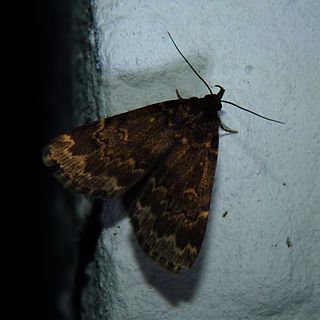
Idia lubricalis, the glossy black idia, is a litter moth of the family Erebidae. The species was first described by Carl Geyer in 1832. It is found from Canada south to Florida and Texas in deciduous forests.
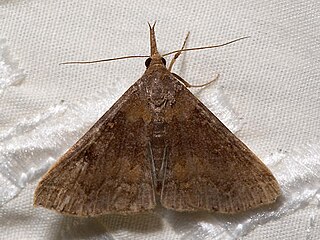
Renia discoloralis, the discolored renia, is a litter moth of the family Erebidae. The species was first described by Achille Guenée in 1854. It is found in the United States from Missouri to southern New England, south to at least North Carolina and possibly Florida and Texas, but this might be an unnamed relative.
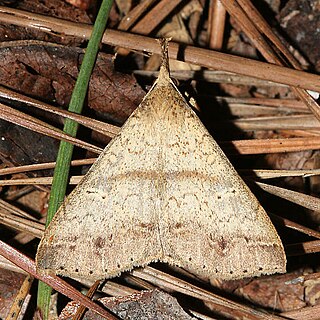
Renia adspergillus, the gray renia or speckled renia moth, is a litter moth of the family Erebidae. The species was first described by Louis Augustin Guillaume Bosc in 1800. It is found in North America from Michigan to Quebec and south to Louisiana and Florida.

Renia factiosalis, the dark-banded renia or sociable renia moth, is a litter moth of the family Erebidae. The species was first described by Francis Walker in 1859. It is found from southern Canada to Florida and Texas.

Renia sobrialis, the sober renia, is a litter moth of the family Erebidae. The species was first described by Francis Walker in 1859. It is found from Nova Scotia to Florida, west to Mississippi and Minnesota.

Palthis angulalis, the dark-spotted palthis, is a moth of the family Erebidae. The species was first described by Jacob Hübner in 1796. It is found from Newfoundland west to coastal British Columbia, south to Florida and Texas.

Plagodis alcoolaria, the hollow-spotted plagodis, is a moth of the family Geometridae. The species was first described by Achille Guenée in 1857. It is found in eastern and central North America.

Hypagyrtis unipunctata, the one-spotted variant moth or white spot, is a moth of the family Geometridae. The species was first described by Adrian Hardy Haworth in 1809. It can be found from Nova Scotia to Florida, west to Texas, northwest to British Columbia. It is also found in Eurasia.
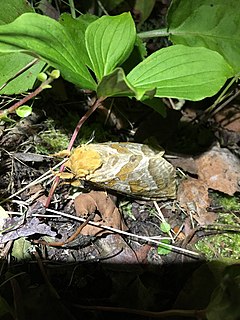
Sthenopis purpurascens, the four-spotted ghost moth, is a species of moth of the family Hepialidae. It was described by Packard in 1863. It is found in Canada and the United States, from Labrador and New York north and west to British Columbia and the Northwest Territories, south in the mountains to Arizona.



















